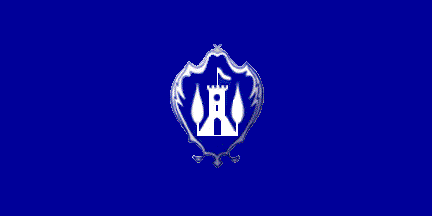

Last modified: 2013-08-04 by ivan sache
Keywords: herceg novi | tower (white) | water polo | cross (blue) | letter: j (white) |
Links: FOTW homepage |
search |
disclaimer and copyright |
write us |
mirrors
Flag of Herceg Novi (reconstruction, no original seen) - Image by Ivan Sache, 8 February 2009
See also:
The municipality of Herceg Novi (33,034 inhabitants in 2005; 12,739 inhabitants in the town of Herceg Novi proper; 235 sq. km) is located
between the highest mountain of the Dinara massif, Orjen (1,895 m asl),
and the entrance of the Bay of Kotor.
Evidence of humans living in Herceg Novi dates from its first known
inhabitants, the Illyrians.
Commercial opportunities attracted Greek traders in the Vth century BC. In the IIIrd century AD, the Romans defeated the Illyrians and took over this region. After the fall of the Western Roman Empire, in 476, Byzantium ruled for the next six centuries. In the VIIth century,
Slavic tribes densely inhabited this region. The Serbian Nemanjić
family ruled the area upon the death of Czar Dušan, Dračevica was
governed by Duke Vojislav Vojinović, and later on by the Balšić
family.
The town of Herceg Novi was founded in 1382, by the Bosnian Ban
(provincial lord) King Tvrtko I Kotromanić in the Bay
of Topla, with an intent to give it a commercial, maritime and craft
role, and named it Sveti Stefan (St. Stephen).
As one the youngest cities on the Adriatic coast, it was called Novi
(New), Castrum Novum, Castel Nuovo. Its current name was coined
during the reign of Herceg (Duke) Stjepan Vukčić Kosača, when the
town experienced its greatest progress.
The area was occupied by the Venetians, the Turks, the Spaniards, Austro-
Hungary, Spain again, Italy, France, Germany...
Tourism in the area dates back to the XIXth century as testified by Simo
Matavulj's records on the Šjora Roza's Inn. The Coffee House "Bella
vista", owned by Savo Bažanović's family, with 25 beds
for "foreigners" was mentioned for the first time in 1872, while the first hotel was bulit in 1909.
Source: Municipal website
Milan Jovanović, 4 September 2007
The region of Herceg Novi was given to the Ottoman Turks by the Republik of Dubrovnik at some point, just as was the area around Neum, in the north of Dubrovnik - as a buffer zone to isolate Dubrovnik territory from that of Venice. These two strips of land eventually became parts of Bosnia and Herzegovina and in time occupied by Austria-Hungary. The historical borders were retained until the reorganization of the Kingdom of Serbs, Croats and Slovenes into banates, and reverted after the Second World War - however, the correction of the Bosnia and Herzegovina border to the benefit of Montenegro was made when the borders were finally established (in 1947?) - so Herceg Novi became a Montenegrin town.
Željko Heimer, 4 September 2007
According to the PR department of the municipal administration of Herceg Novi, the municipal flag is in proportions 1:3, blue with the municipal coat of arms in the middle.
Milan Jovanović, 4 September 2007
The coat of arms was, undoubtedly, designed after the seal of the
town, dated 1865, shown on the municipal website. The writing on the
seal's rim reads "Opstina Herceg Novska - Boka Kotorska", recalling
the location of the town at the entrance of the Bay of Kotor.
The fortress depicted on the coat of arms must be the Clock Tower,
described as follows on the municipal website:
Sahat kula (Tora, i.e. the Clock Tower), was built in 1667 on the order of Sultan Mahmud. During the Turkish rule, this was the main gate of the town. There is a sculpture of Madonna in its arcade (called the "Black Madonna", since it was made as a bas-relief by Afran Hozić; from Sarajevo, in burnt wood in remembrance of the founder of the town, Tvrtko I Kotromanić).
The clock on the tower was replaced by an electric one only in 1995, given by the town of Zemun.
Ivan Sache, 8 February 2009
Flag of PVK Jadran - Image by Ivan Sache, 8 February 2009
Herceg Novi is the home of Plivački Vaterpolo Klub Jaran Herzeg Novi (Swimming Water Polo Club Jaran Herzleg Novi), founded in 1926. The oldest water polo club in former Yugoslavia, PVK Jadran won the
national title in 1958 and 1959, both times with no game lost, and,
subsequently, three more national titles and two national cups.
The flag of PVK Jadran, as shown graphically on the Herceg Novi
municipal website, is a white burgee bordered yellow, quartered by a
blue cross and with a red canton charged with a white "J".
Ivan Sache, 8 February 2009